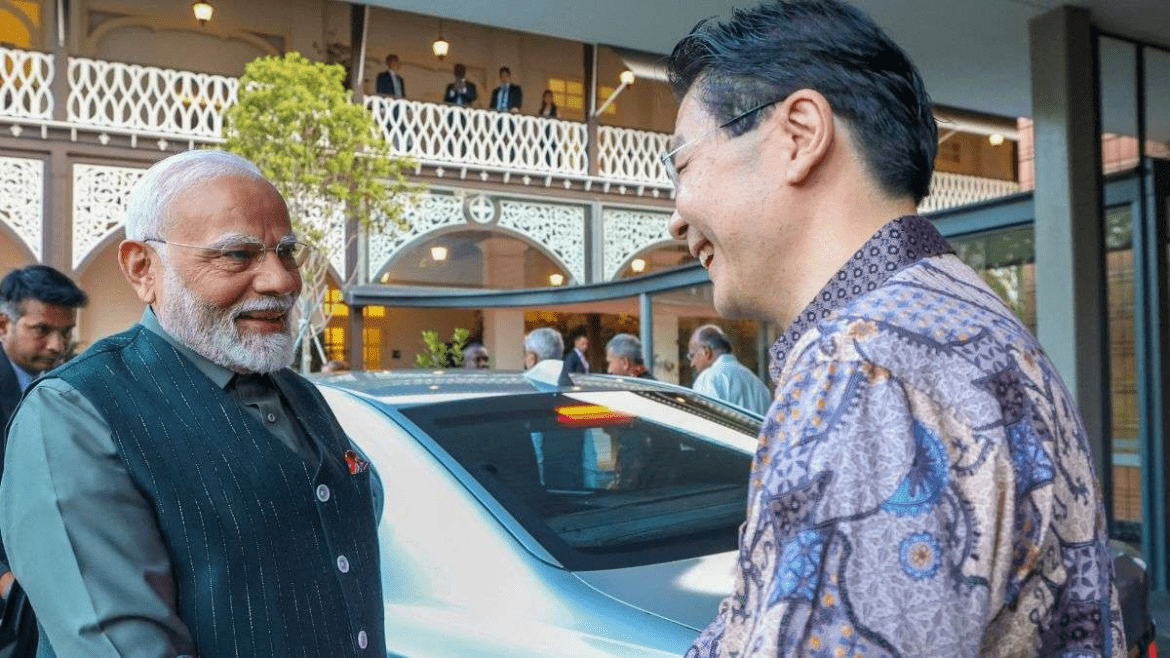AI Generated Summary
- As India and Singapore continue to strengthen their economic and strategic ties, their partnership could serve as a model for regional cooperation, contributing not only to the prosperity of their own nations but also to the stability and growth of the broader Asia-Pacific region.
- As India positions itself as a global manufacturing and technological hub, Singapore could serve as a gateway to global markets for Indian companies, leveraging its advanced infrastructure and international networks.
- Prime Minister Narendra Modi’s recent visit to Singapore marks a new chapter in the already flourishing relationship between India and the city-state.
Prime Minister Narendra Modi’s recent visit to Singapore marks a new chapter in the already flourishing relationship between India and the city-state. Though many may be unaware, Singapore was once governed from Kolkata until 1867, illustrating the long history shared by the two nations. Today, the partnership has evolved into a robust economic and strategic alignment that holds significant promise for both countries.
A Financial Anchor for the Indian Economy
Singapore’s economic influence on India cannot be overstated. With investments totaling over $160 billion in the past two decades, Singapore has become India’s largest source of foreign direct investment (FDI). These investments have propelled India’s economic growth, transforming key sectors, including telecommunications. Singapore’s early backing of Bharti Airtel was instrumental in igniting India’s telecommunications revolution, demonstrating the city-state’s forward-thinking investment strategy.
One of the most recent developments is CapitaLand’s commitment to increase its investment in India to $14.8 billion, a move that signals growing confidence in India’s economic potential. In 2024, India’s trade with Singapore reached $35.6 billion, with Indian imports from Singapore standing at $21.2 billion, and exports at $14.4 billion. While this trade imbalance favors Singapore, it underscores the complementary nature of both economies. India’s growing middle class fuels demand for Singaporean goods, while Singapore benefits from India’s vast pool of raw materials and talent.
Strategic Convergence in Defence and Beyond
The relationship between India and Singapore is more than economic; it has taken on a strategic dimension in recent years, largely driven by shared concerns over China’s growing assertiveness in the region. The Singapore-India Maritime Bilateral Exercise (SIMBEX), the longest continuous naval exercise India has with any nation, exemplifies the deepening military cooperation. Held annually since 1994, SIMBEX is a testament to the enduring strategic trust between the two nations.
However, it may be time for the partnership to evolve beyond joint exercises. The Indian Air Force already maintains a long-term presence in Japan, and similar arrangements with Singapore could help further solidify India’s role as a regional power. Singapore’s substantial defence spending—over 3% of its GDP—makes it a key partner for India, particularly as India looks to increase its defence exports, including ammunition and advanced military hardware.
The strategic partnership is not limited to defence. Singapore’s critical location along global shipping routes complements India’s expanding naval capabilities, providing a natural synergy that could enhance security and stability in the Indo-Pacific region.
Expanding Cooperation in Emerging Sectors
New areas of collaboration are also emerging, particularly in health and semiconductor technologies. These sectors represent the next frontier in the India-Singapore partnership, promising mutual benefits in cutting-edge fields. Furthermore, Indian companies are increasingly looking to Singapore’s Stock Exchange to raise capital, a reflection of the deepening financial integration between the two economies.
The potential for greater cooperation is immense, particularly with India’s GIFT City in Gujarat offering Singaporean companies an onshore opportunity to engage more deeply with the Indian economy. As India positions itself as a global manufacturing and technological hub, Singapore could serve as a gateway to global markets for Indian companies, leveraging its advanced infrastructure and international networks.
A Strategic Partnership for the Asia-Pacific
India’s relationship with Singapore has now reached the same level of strategic importance as its ties with Japan. Both countries are indispensable partners for India as it seeks to assert itself in the Asia-Pacific region. Prime Minister Modi’s visit signals that this relationship will only deepen in the years ahead, with both nations set to benefit from their complementary strengths.
As India and Singapore continue to strengthen their economic and strategic ties, their partnership could serve as a model for regional cooperation, contributing not only to the prosperity of their own nations but also to the stability and growth of the broader Asia-Pacific region. The future of this relationship is bright, and both countries stand to gain from their continued collaboration.
The opinions expressed in this article are those of the author. They do not purport to reflect the opinions or views of Khalsa Vox or its members.




